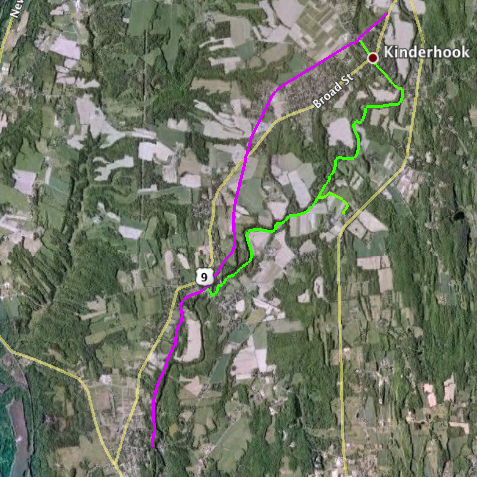The Towns of Kinderhook, Stockport and Stuyvesant in Columbia County, New York have received a grant from the Hudson River Valley Greenway Conservancy for a trails feasibility study. Between September and December 2010, the the Fall 2010 Planning Studio at the University at Albany, SUNY Department of Geography and Planning conducted the feasibility study in conjunction with the Joint Trail Committee from Kinderhook, Stockport and Stuyvesant.
The primary trail routes to be assessed in the study included:
(1) the National Grid right-of-way from the Village of Kinderhook westerly village line to Rossman Road in the Town of Stockport (indicated as purple in map below). This segment is approximately 5.5 miles long.
(2) from the easterly Village of Kinderhook line, at the Hudson St crossing of the Kinderhook Creek, to the Martin Van Buren National Historic Site (Lindenwald) and to the hamlet of Stuyvesant Falls, connecting to National Grid right-of-way, just west of the County Rt. 25 crossing of the Kinderhook Creek (indicated as green). Approximately 5 miles.
The area along the proposed trails has some of the region’s most picturesque natural locales including the Stuyvesant Falls,the Chittenden Falls, vistas and local flora.


I just received the email from the Hudson River Valley Greenway Conservancy concerning the proposed recreational trail along the National Grid right-of-way. The email suggests “Imagine kids from Stuyvesant Falls being able to ride their bikes to school in Kinderhook.”
In 1997 I served on a National Academy of Science committee on the Possible Effects of Electromagnetic Fields on Biologic Systems; we published the results in “Possible Health Effects of Exposure to Residential Electric and Magnetic Fields.” One strong conclusion from the epidemiology was that living very near power lines “is associated with about a 1.5-fold excess of childhood leukemia.” That result is unsettling. I recommend that you not use a power line right-of-way for a recreational trail — particularly one that will be used by children.
Daniel A. Driscoll, PhD
Thank you for the comment!
The study will review research like this one to assess the possible harm from the power lines’ electromagnetic fields, taking into consideration that this power line is not high-voltage and that trail users would be active and mobile, and not sedentary, greatly reducing any possible risk of exposure.
is there a choice between the National Grid right of way and the one along the Kinderhook? The one along the stream would be so much more atractive, and usable in the summer, than a power line.
Hope it comes to pass!
Thank you for the comment Janet.
The vision is that both the National Grid right-of-way and Creek trail would connect the Towns and their attractive/historic sites. As part of the study, the proposed trails will be prioritized into segments with recommendations on which pieces should be first tackled. Your comment about the Creek trail will help in that prioritization.
The study Dr, Driscoll references shows only hypothetical links.. and actually concludes “Based on a comprehensive evaluation of published studies relating to the effects of power-frequency electric and magnetic fields on cells, tissues, and organisms (including humans), the conclusion of the committee is that the current body of evidence does not show that exposure to these fields presents a human-health hazard. Specifically, no conclusive and consistent evidence shows that exposures to residential electric and magnetic fields produce cancer, adverse neurobehavioral effects, or reproductive and developmental effects.”
While I support further research.. the comment is not 100% fair.
http://books.nap.edu/openbook.php?record_id=5155&page=1